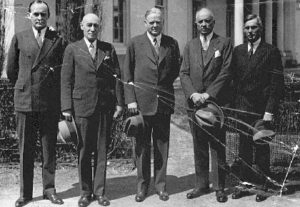
President Herbert Hoover, General Hines and Staff, Following the Signing of Executive Order Creating the Veterans Administration, courtesy U.S. Veterans Administration
One reason that Dr. Hummer pinched pennies at the Canton Asylum for Insane Indians was because his per capita costs were so high. Most experts at the time felt that no asylum with fewer than 500 patients could be run efficiently, and Hummer didn’t reach a fifth of that number at his very fullest. However, Dr. John Grimes (see last post) found that government veterans hospitals were being run quite well. The country had about 20 VA hospitals, which were usually established with ample space on grounds which were beautifully kept.
“Overcrowding is not permitted,” said Grimes. “Space originally provided for other purposes is not transformed into dormitories.” He also found that dormitory buildings on many hospital grounds housed 50 patients or fewer (though the hospitals themselves had several hundred patients). The furnishings were comfortable, and patients had plenty of space, with “provisions for reclining, sitting, walking, and playing, much more ample than in other hospitals publicly maintained.” Grimes saw that painting and decorating in the VA hospitals were very nice; decorations weren’t cheap and “by no means limited to the products of the departments of occupational therapy.”
Grimes’ findings show that government hospitals could be well kept, with adequate staff and the many niceties that made long-term care comfortable. At the Canton Asylum, Dr. Hummer removed all pictures and decorations because patients sometimes pulled them down to use as weapons in their fights–never thinking to attach them permanently to the walls.
Patient Susan Wishecoby pointed out an even sadder failure: “They call this an Indian Asylum and then why don’t the Indians have it more like their home?”

Civil War Veterans Receiving Care at National Bath Branch of the Soldiers Home, courtesy U.S. Department of Veterans Affairs

VA Hospitals had Impressive Architecture
______________________________________________________________________________________



